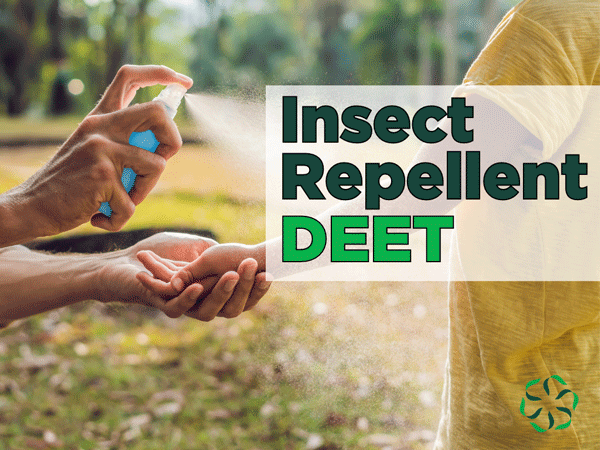In our last post, we looked at insect repellents available to us. We established that EPA-registered products are known to be the most effective. In this post, we look at one of the most commonly used EPA-registered insect repellent ingredients: DEET
What are insect repellents?
Insect repellents are products that help prevent, repeal, or mitigating pests. These can be products that we apply to our skin or products like lanterns or candles that use a heating mechanism to disperse repellents (1).
This post will focus on products that we apply topically, such as a spray or lotion.
What are EPA-approved insect repellent ingredients?
EPA-registered active ingredients include:
- 2-undecanone
- Catnip oil
- DEET
- IR-3535
- Oil of Citronella
- Oil of Lemon Eucalyptus
- Picaridin
- q-Methane-3,8-diol (pmd)
The most commonly used ingredient in EPA-approved insect repellents is DEET, and we find it in more than 500 products.
What is DEET?
DEET is the term used for the chemical ingredient N,N-diethyl-meta-toluamide that can repel mosquitoes and ticks that may carry harmful diseases.
DEET works by interfering with the receptors on a mosquito’s antennae making it harder for it to detect our presence, therefore they’re unable to find us to bite us (1,2).
DEET’s been in use since the late 1940s and has been studied extensively. Research shows it’s safe and effective when used as directed (1,2,3,4,5).
Why use DEET rather than other EPA-registered ingredients?
The U.S. Centers for Disease Control and Infection (CDC) recommends the use of DEET products because extensive research shows DEET is safe and highly effective at preventing mosquito and tick bites. It’s also the most commonly used EPA-registered ingredient in insect repellent products (1,2,3,4,5).
Using safe and effective DEET containing insect repellent products helps prevent the spread of harmful insect-borne diseases like malaria, Zika, West Nile, Lyme Disease, and more. These diseases can cause severe illness, and the potential for contracting these diseases decreases with proper preventative measures, including using insect repellent (1,2).
How much DEET should I use?
DEET comes in many concentrations, from 4%-100%. The concentration determines how long the repellent properties last rather than how many bugs it will prevent from biting you. In other words, if you choose a product that contains a high concentration of DEET, you will not need to reapply it as frequently as a product that contains a low DEET concentration. The protection is the same. The duration is the difference (1).
While there are high concentration DEET products, research shows that there is little difference among products containing concentrations above 50% with respect to how long they remain effective (1).
The CDC recommends applying products with approximately 20% DEET concentration (1).
Is it safe to use? Even for children and pregnant and nursing mothers?
When used according to the directions, DEET is safe and even recommended for use by all populations who may be exposed to potentially disease-carrying mosquitos and ticks (1,2,3).
The EPA’s data shows it’s safe for all children regardless of age. However, the American Academy of Pediatrics (AAP) recommends using DEET-containing products only on children older than two months of age (1,2).
We should never apply DEET-containing products directly to children’s hands or faces. Additionally, the AAP recommends that children wash off the DEET after it’s no longer needed (1,2).
Again, when used as directed, DEET-containing products are safe for pregnant and nursing mothers (1).
Can I have a reaction to DEET?
Although rare, DEET-containing products can cause some people to have skin irritation or reactions. In that case, you should wash the area to remove any product, discontinue use, and contact a medical professional if it is severe (1).
The good news.
It can be good for our health to spend time in nature, enjoying the outdoors. We know DEET-containing products are safe and effective when used correctly and can help us have fun outside with fewer bug bites

